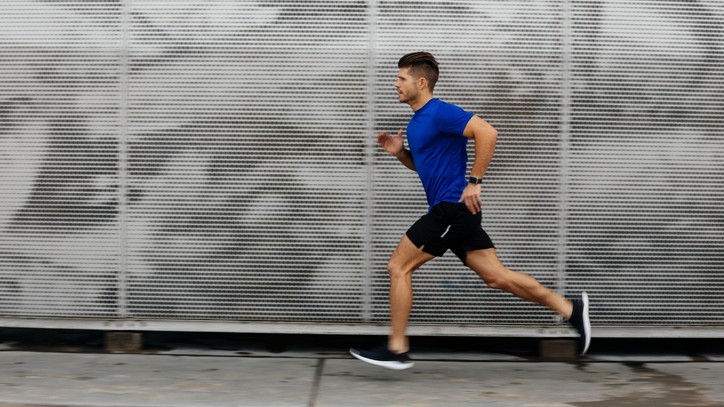Does running increase testosterone?
Fact or fiction – does running increase testosterone? We speak to the experts to find out.

As a form of exercise, its physical and mental health benefits are well documented, but does running increase testosterone levels?
Higher testosterone levels are associated with numerous health benefits including boosted bone density, increased muscle growth and improved mood, so it’s easy to see why people might want more of this hormone. Weightlifting is usually touted as the best way to boost your testosterone levels – but could hopping on one of the best treadmills have the same effect?
To answer this, it’s important to first understand what testosterone is and the many effects it has on the body.
We spoke to Dr Noel Young, a medical doctor with an interest in lifestyle and preventative medicine, to find out more about the impact running can have on testosterone levels.

Dr. Rebecca Breslow is a physician, researcher, and writer. A graduate of Yale University, she did her medical training at Harvard Medical School, Brigham and Women’s Hospital, and Boston Children’s Hospital. She was a practicing physician in academic medicine for 17 years, during which time she authored numerous publications for academic and lay audiences. Currently, she focuses on freelance medical writing and editing to help make medical, health, and wellness information accessible to a broad audience.
- Read more: How running changes your body
- Read more: Expert running tips from a sports scientist
What is testosterone?
It’s probably a word you’ve heard many times before, but what is testosterone?
“Testosterone is a steroid hormone responsible for the development of what’s called secondary sexual characteristics, or changes that occur during puberty,” says Dr Young.
“For males it causes your larynx to thicken and your voice to deepen, facial and pubic hair growth, and development of the penis and testes.”
Get the world’s most fascinating discoveries delivered straight to your inbox.
Crucially, for those interested in the link between testosterone levels and athletic performance, it also helps build muscle and bone strength.”
It is often called the male sex hormone, and is made by the testes,” Dr Young says. However, he adds: "It is also present at lower levels in women, where it's made by the adrenal gland and ovaries.
“In women, it’s responsible for libido and arousal, and also plays a role in developing muscle and bone strength.”
Benefits and drawbacks of higher testosterone levels

Higher testosterone levels have been associated with boosted bone density, increased muscle growth and improved mood. “It’s tempting to think that more must be better, but that is not the case,” says Dr Young.
“Having too much testosterone can lead to issues such as skin and hair problems, prostate enlargement and reduced fertility. It can also lead to poorer heart health from weight gain, higher cholesterol and elevated blood pressure.”
Instead, he suggests maintaining healthy levels of testosterone, as both lower and higher levels are associated with ill effects.
“When your testosterone levels are optimal, you have better energy, heart health, mood, memory, and libido. You also have stronger bones and a leaner body mass,” he says.
A 2010 review published in Sports Medicine explores how testosterone can positively impact muscle growth due to resistance exercise training. The authors explain: “Testosterone is one of the most potent naturally secreted androgenic-anabolic hormones, and its biological effects include promotion of muscle growth. In muscle, testosterone stimulates protein synthesis and inhibits protein degradation; combined, these effects account for the promotion of muscle hypertrophy by testosterone.”
Furthermore, testosterone can positively impact the skeletal system. It is important for bone density, which decreases with age making your bones weaker and increasing the risk of osteoporosis. Higher levels of testosterone reduce this risk.
Does running increase testosterone?
“Running could have an impact on testosterone, but it depends on the intensity at which you run,” Dr Young explains. “Evidence suggests that high-intensity running, like sprinting, boosts testosterone.
“The mechanism for this is thought to be due to the body’s response to exercise, where it releases a variety of hormones that break down energy stores (like adrenaline and cortisol) and help build and repair muscles and bones (like testosterone).”
But, he warns, running for longer time periods can lead to reduced testosterone levels.
“This is because of the effects of cortisol. Cortisol is a stress hormone, and has a see-saw-like relationship with testosterone. As cortisol production goes up, testosterone goes down and vice versa. Prolonged exercise can lead to increases in cortisol and decreases in testosterone.”
The decrease in testosterone caused by excessive running is not normally large enough to create any significant health problems, but overtraining can cause quality of life issues such as stress fractures and fatigue etc.
- Read more: What muscles are used for running
Best exercise for increasing testosterone levels
Research shows anyone looking for a testosterone-boosting physical activity should turn to resistance training methods such as bodybuilding and weightlifting, rather than running.
In a study published in the European Journal of Applied Physiology, male university students who engaged in resistance training three times per week had elevated levels of testosterone in their urine following heavy resistance exercise. However, the same study found that testosterone response to resistance training in women was “equivocal.”
“Resistance training, or strength and weight training, is especially good for boosting testosterone levels,” Dr Young says. “This effect is seen as more muscle mass is activated. So doing squats over bicep curls, or using free weights over machine exercises, will be better as both involve larger muscle groups such as your core, back and thighs.”
“Exercising to exhaustion, however, leads to a drop in testosterone. So it’s important not to overstretch yourself and allow sufficient time for recovery in between exercise sessions.”
- Read more: Do testosterone supplements really work?

Other factors that can increase testosterone production
As mentioned earlier in this article, stress and consequent cortisol production can lower testosterone levels. By managing stress levels, you can mitigate this effect.
Dr Young suggests the use of methods such as mindfulness and deep breathing to reduce stress levels. He also says practicing good “sleep hygiene” can have a positive effect on stress levels.
“Getting too little sleep can increase stress hormones in your body, which lowers testosterone,” he says. One review of the relationship between sleep, stress and metabolism, published in Sleep Science, highlighted that levels can reduce by 10 to 15 percent after reducing sleeping time to five hours for five days. Instead, you should aim for between seven to nine hours of good quality sleep.
There are also dietary factors you can focus on, to ensure your testosterone levels don’t drop.
“Ensure you get enough magnesium and zinc in your diet,” advises Dr Young. “Zinc is involved in the production of testosterone, and deficiencies have been linked to low testosterone states. Low magnesium is also associated with low testosterone, though the exact role it plays in testosterone production is still not clear. Good sources of zinc include pumpkin seeds, spinach and chia seeds, while good sources of magnesium include spinach, kale and beans."
References
Jakob L Vingren et al. (2010). Testosterone physiology in resistance exercise and training: the up-stream regulatory elements. Sports Medicine - accessed April 2022.
Camilla Hirotsu et al. (2015). Interactions between sleep, stress, and metabolism: From physiological to pathological conditions. Sleep Science - accessed April 2022.
Rafael Timon Andrada et al. (2007). Variations in urine excretion of steroid hormones after an acute session and after a 4-week programme of strength training. European Journal of Applied Physiology - accessed April 2022.

Harry Bullmore is a fitness writer covering everything from reviews to features for LiveScience, T3, TechRadar, Fit&Well and more. So, whether you’re looking for a new fitness tracker or wondering how to shave seconds off your 5K PB, chances are he’s written something to help you improve your training.
When not writing, he’s most likely to be found experimenting with a wide variety of training methods in his home gym or trying to exhaust his ever-energetic puppy.
Prior to joining Future, Harry wrote health and fitness product reviews for publications including Men’s Health, Women’s Health and Runner’s World. Before this, he spent three years as a news reporter with work in more than 70 national and regional newspapers.
- Dr. Rebecca BreslowPhysician, researcher, and writer.


